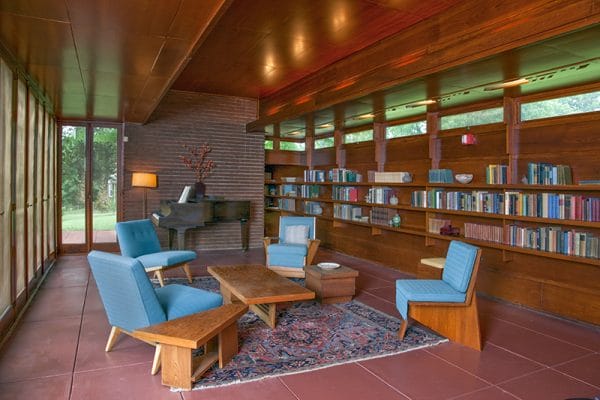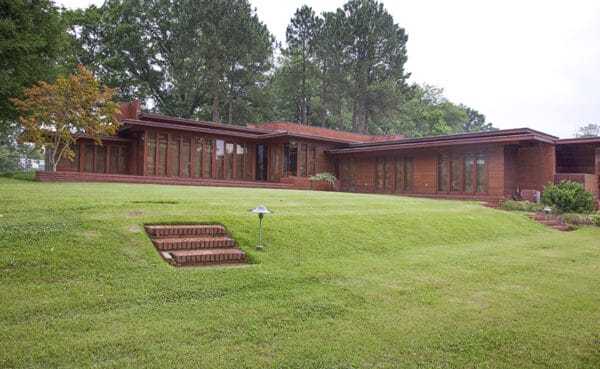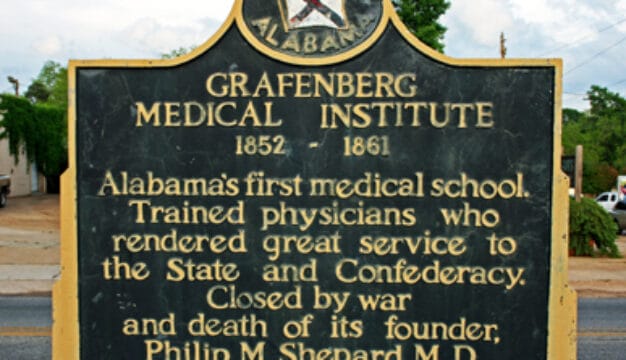Rosenbaum House Museum
 Rosenbaum House
The Rosenbaum House in Florence, Lauderdale County, is the only dwelling in Alabama designed by American architect Frank Lloyd Wright (1867-1959). Built on the banks of the Tennessee River toward the end of the Great Depression, it exemplifies Wright’s “Usonian” period, a departure from the design of the grand structures that made him famous. The style focuses on single-dwelling homes that were low-cost and “organic,” that is, built to extend from and follow the contours of the landscape. Now a museum, the Rosenbaum House is one of Florence’s cultural points of interest.
Rosenbaum House
The Rosenbaum House in Florence, Lauderdale County, is the only dwelling in Alabama designed by American architect Frank Lloyd Wright (1867-1959). Built on the banks of the Tennessee River toward the end of the Great Depression, it exemplifies Wright’s “Usonian” period, a departure from the design of the grand structures that made him famous. The style focuses on single-dwelling homes that were low-cost and “organic,” that is, built to extend from and follow the contours of the landscape. Now a museum, the Rosenbaum House is one of Florence’s cultural points of interest.
In April 1939, newlyweds Mildred and Stanley Rosenbaum, who later taught in the English department at Florence State University (present-day University of North Alabama), contracted with Wright to build them a new home. Wright drew up an L-shaped floor plan based on his first Usonian design, the Jacobs House in Madison, Wisconsin. Usonia was Wright’s name for his utopian ideal of America laid out in a simpler and more natural architectural style. Totaling 1,540 square feet, the plans featured a striking horizontal exterior of cypress wood, brick, and glass, with cantilevered roofs (supported on one end only) for the house and a carport, a Wright invention. Inside was an advanced heating system that piped hot water beneath concrete slab floors, a spacious open living room, and a central “service core” including the kitchen and a stone hearth at the corner of the L-shape. The core was built of heavy materials to bear the load of the cantilevered roofs. Following his philosophy of learn-by-doing construction, Wright sent Burt Goodrich, an inexperienced apprentice from his Arizona architectural campus known as Taliesin West, to supervise the project. Goodrich began construction in January 1940, and after months of construction delays resulting from scarce materials, untrained labor, and inhospitable weather, the Rosenbaums took up residence on August 23, 1940. Although the Rosenbaums’ budget was $7,500, by the time the house was finished the cost had risen to approximately $14,000.
 Rosenbaum House Exterior
Problems plagued the house immediately. The roofs were designed to have slight inclines but were instead flat; the roof sealant failed, which caused leaking. Also, the chimneys were defective. But by 1946, the Rosenbaums, with three boys and another on the way, had asked Wright to design an addition, the first Usonian structure to undergo such a change. Wright appointed former apprentice Ben Dombar to supervise the project. The addition’s cost was projected to be $15,000, but likely exceeded $40,000. When the 1,084-square-foot addition was completed in November 1948, the house had a larger kitchen, a dormitory for the boys, a guest room, a second carport, and another L-shaped wing surrounding a Japanese garden.
Rosenbaum House Exterior
Problems plagued the house immediately. The roofs were designed to have slight inclines but were instead flat; the roof sealant failed, which caused leaking. Also, the chimneys were defective. But by 1946, the Rosenbaums, with three boys and another on the way, had asked Wright to design an addition, the first Usonian structure to undergo such a change. Wright appointed former apprentice Ben Dombar to supervise the project. The addition’s cost was projected to be $15,000, but likely exceeded $40,000. When the 1,084-square-foot addition was completed in November 1948, the house had a larger kitchen, a dormitory for the boys, a guest room, a second carport, and another L-shaped wing surrounding a Japanese garden.
Stanley Rosenbaum died in 1983; Mildred remained in the house until 1999, when she sold it to the city of Florence for $75,000, with the understanding that it would be restored and made into a museum. Restoration began in December 1999, with major structural repairs for water and termite damage carried out by Lambert-Ezell Architects and B. H. Craig Construction Co., as well as updating wiring and the heating and cooling system. Original Wright furniture was purchased with the home, and all items were removed and documented as renovations were carried out. The restoration was completed in July 2002. The cost of renovation, estimated at between $600,000 and $700,000, was covered by a $0.01 city sales tax increase.
Additional Resources
Broach, Barbara Kimberlin. Frank Lloyd Wright’s Rosenbaum House: The Birth and Rebirth of an American Treasure. San Francisco: Pomegranate, 2006.
Rosenbaum, Alvin. Usonia: Frank Lloyd Wright’s Design for America. Washington, D.C.: Preservation Press, National Trust for Historic Preservation, 1993.
Sergeant, John. Frank Lloyd Wright’s Usonian Houses: The Case for Organic Architecture. New York: Whitney Library of Design, 1984.



